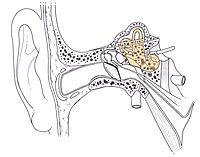Benign paroxysmal vertigo of childhood facts for kids
Benign paroxysmal vertigo of childhood (BPVC) is a type of dizziness that affects children. The name sounds complicated, but it just means 'harmless dizziness that comes and goes suddenly.'
When a child has BPVC, they usually feel like they are moving or spinning. Sometimes, it feels like the inside of their head is spinning.
BPVC often starts in children between two and five years old. It usually goes away by the time they are eight. However, some children might start having BPVC when they are very young (a few months old) or older (up to 12 years old).
BPVC is the most common reason for dizziness in kids who don't have hearing problems or an ear disease. It's quite common, affecting about 2.6% of children (that's 26 out of every 1,000 children).
Contents
What Causes Benign Paroxysmal Vertigo?
Doctors are not completely sure what causes BPVC. Some doctors think it might be linked to problems in the inner ear. The inner ear helps us keep our balance. For example, some doctors believe BPVC is similar to a problem often seen in adults over 50. This adult problem is called benign paroxysmal positional vertigo (BPPV). BPPV is a "vestibular disorder," which means it's a problem in the inner ear that affects balance.
Other doctors think BPVC might be related to migraine headaches. However, most children with BPVC do not get headaches.
What Are the Signs of BPVC?
Children with BPVC may show several signs during an attack:
- Nystagmus (sometimes called "dancing eyes"): This is when the eyes make fast, uncontrollable movements. These eye movements can happen on their own or when a child stares at something. When a child with BPVC is not dizzy, they might still have positional nystagmus. This happens when their head is in a certain position.
- Nausea: Feeling like they need to throw up.
- Vomiting: Actually throwing up.
- Gait ataxia: Having trouble walking because their muscles don't work together well. This can be harder to notice in infants who haven't learned to walk yet.
- Postural imbalance: Having difficulty staying balanced, which makes it hard to stand up straight. This sign can also be harder to see in infants who cannot stand yet.
- Looking scared: Children might look scared because of the dizziness and loss of balance they are feeling.
How Do Doctors Diagnose BPVC?
For a doctor to say a child has Benign Paroxysmal Vertigo of Childhood, several things must be true:
- The child has had at least five attacks of dizziness.
- The dizziness happens suddenly and goes away after a few minutes to a few hours.
- The child had a normal neurological examination. This test checks how the brain is working.
- Between attacks, the child had normal hearing and no obvious problems with their inner ears. These are called normal audiometric and vestibular functions.
- The child had a normal electroencephalography (EEG). This is a test that looks for unusual electrical activity in the brain.
What Else Could It Be?
When doctors look for a diagnosis, they also consider differential diagnoses. These are other medical problems that could cause the same symptoms. Before a doctor makes a final diagnosis, they think about what other conditions have similar symptoms. They need to make sure one of those isn't the real problem.
Some other conditions that can have similar symptoms to BPVC include:
- Posterior fossa tumor: This is a tumor in the part of the brain near the bottom of the skull. These tumors are more common in children than in adults.
- Cervical spine abnormalities: These are problems with the part of the spine in the neck.
- Otological disorders: These are problems with the inside parts of the ears.
- Benign occipital epilepsy: This is a type of epilepsy that most children outgrow.
- Metabolic disorders: These are problems with how the body turns food into energy.



